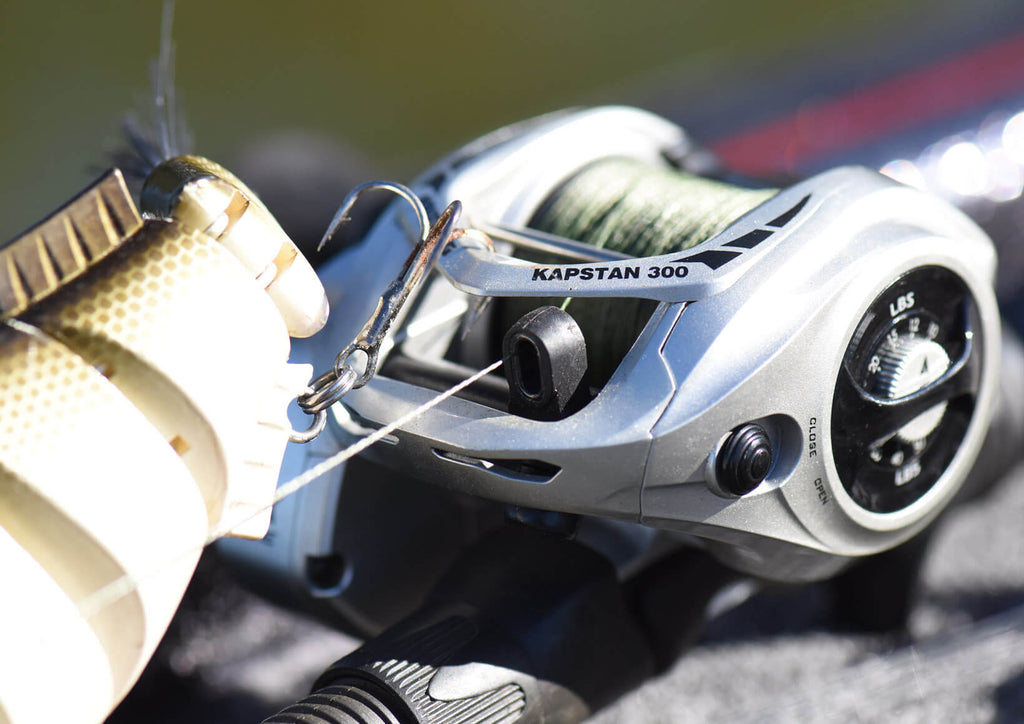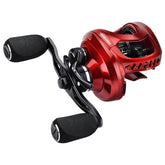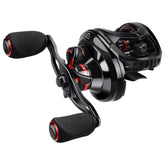
How to Spool a Baitcaster
Learn how to spool a baitcaster in easy steps, along with some fishing tackle tips from a Veteran angler.
The first time I picked up a baitcaster as a child, I was beyond intimidated. I knew how much practice, dedication and attention to detail it takes to be effective with one. I watched my father day in and day out use, practice and maintain his fishing collection. I was given some monofilament line on a spool and a pencil to get my reel spooled. I realized how different it is to spool a baitcaster versus a spinning reel. Over the past few years, technology has made respooling much easier but still a process that takes time and attention to detail to have the most success. While spooling your first baitcaster can be intimidating, following these easy steps can ensure you are ready to catch the fish of a lifetime.
Step 1: Getting Your Baitcaster Ready

Getting the baitcasting reel ready to spool is very easy. I prefer to use a rod when spooling my fishing reels. If I am indoors, I will use the bottom section of a two-piece rod. I use a rod because I am able to ensure that the line is going on to the reel straight without much slack. Run the line through the rod guides then run it through the actual line guide on the reel you are going to the spool. It is easy to miss a guide or forget to run the line through the reels line guide so make sure you do both. When selecting a fishing line to use remember that each line is going to have its own diameter. Twenty-pound test monofilament line is going to fill your reel up a lot faster than thirty-pound test of braided fishing line.
Step 2: Tying Fishing Line to Spool

Sometimes getting your fishing line around the reel’s spool can be a little difficult. If you have a way of removing your side plate, I definitely suggest doing that to get the spool out and tying a proper knot. If you are not able to remove the reel spool, you can place some of the line into one of the holes in the spool (if it has some) the turn the handle until the line is completely around the spool. The knot I have always used to tie it to the spool in an Arbor Knot. Tying a regular square knot will not hold as the line will slip. Tying a large knot will cause your line to not evenly spool. When using braided line or fluorocarbon fishing line ensure to wet the line when tying and tightening the knot so the line does not burn and weaken itself.
Step 3: Using Line Spooler to Spool a Reel

Securing the line to the spool properly is a very important step that is sometimes over looked. KastKing offers a few tools to properly spool a reel without line twist. One is the Radius Line Spooler and the V10 Rod Rack that has a spooling station built in. Unlike other line spoolers, these line spooler tools allow the line to unroll from the filler spool and directly to the reel without any line twist. Line twist can create a number of problems. When the line is twisted, the strength and durability of the line can become compromised. If the line twist too much it will break under a lot of pressure. When reeling in a fish, every detail counts and any weakness in the line will be exposed. I understand that some people may now be able to purchase a line spooler and there are many different ways to properly hold the line. I’ve seen pictures with a spool of line in a rice cooker and the line is ran through the vent hole. That is a very clever way of doing it, but there is no tension on the line. Proper tension is required to spool your reel correctly. If you are in a pinch and on the water, there are other ways for how to spool a baitcaster. You can always run a pen or screw driver through the line spool and secure it with either your toes or the hole on your Crocs. I know that sounds weird but that the way I did it as a child. You can apply pressure by simply using your feet.
Step 4: Making Sure the Line is Spooling Evenly

Even with a line spooler and your line guide on the reel, you might notice that the line is spooling unevenly or mainly on one side. If this happens apply pressure with your thumb to the uneven side. This is to ensure that the line is spooling evenly and that you are getting the right amount of line on your baitcaster. Having the right amount of line on your fishing reel is very important. Too little and you might run the risk of running out of line on a long cast or even worse; running out of line on a big fish would be absolutely devastating! Maintain a firm grip on your reel and you can keep your thumb on the reel’s spool to maintain proper pressure. When reeling, do not reel too fast and only fill the reel up to about a 1/8th of an inch from the edge of the baitcasters spool lip. If you spool too much line on your casting reel it may interfere with the reel’s ability to function properly. It may hit the reels frame and cause damage to your line. Always keep in mind that a damaged fishing line is a weak line. That is why it is important to learn the correct way of how to spool a baitcaster.
Conclusion
The first time anyone spools a baitcaster, it might be an intimidating task. Remember to be mindful of the type of line you choose. Next, secure the to the reel’s spool. Use an Arbor Knot and it’s very easy if you are able to remove the spool. If not it’s okay it just takes a bit of patience. Then, use a line spooler and make sure the line is running through the rod guides and the reel’s line guide. If you do not have a Line Spooler than use some of the other creative ways for how to spool a baitcaster. Finally, keep the proper tension and do not under fill or over fill your fishing reel. The most effective way I have found to do this is using a tool line the KastKing Radius Line Spooler. It comes with tools to secure and add tension to your line like the KastKing Line Boss. In early 2022 KastKing introduced a new line spooling device called the Kalibrate. It is a patent-pending design that measures the amount of line going on your baitcaster or spinning reel. It adds line to the reel without imparting line twist. Having the proper alignment and proper tension will make maintenance on your equipment a lot easier and ensure you get the most out of your line. I hope you have enjoyed reading my explanation of how to spool a baitcaster.
 Jose Cinco is a freshwater fisherman located in Central Oklahoma. While normally targeting largemouth and smallmouth bass, he also travels across the nation to hunt for trout and catfish. When traveling on the west coast, saltwater sand bass and hybrids are his targeted species.
Jose Cinco is a freshwater fisherman located in Central Oklahoma. While normally targeting largemouth and smallmouth bass, he also travels across the nation to hunt for trout and catfish. When traveling on the west coast, saltwater sand bass and hybrids are his targeted species.












